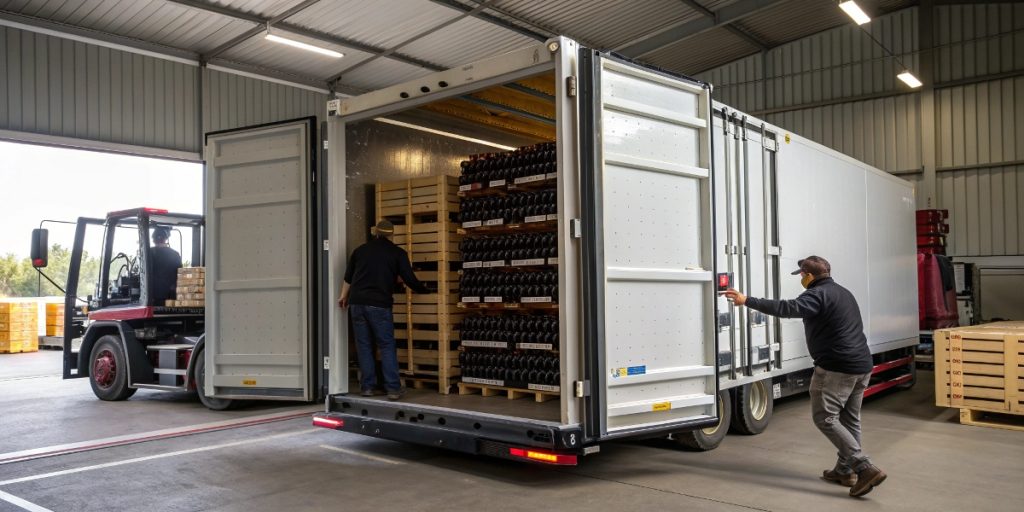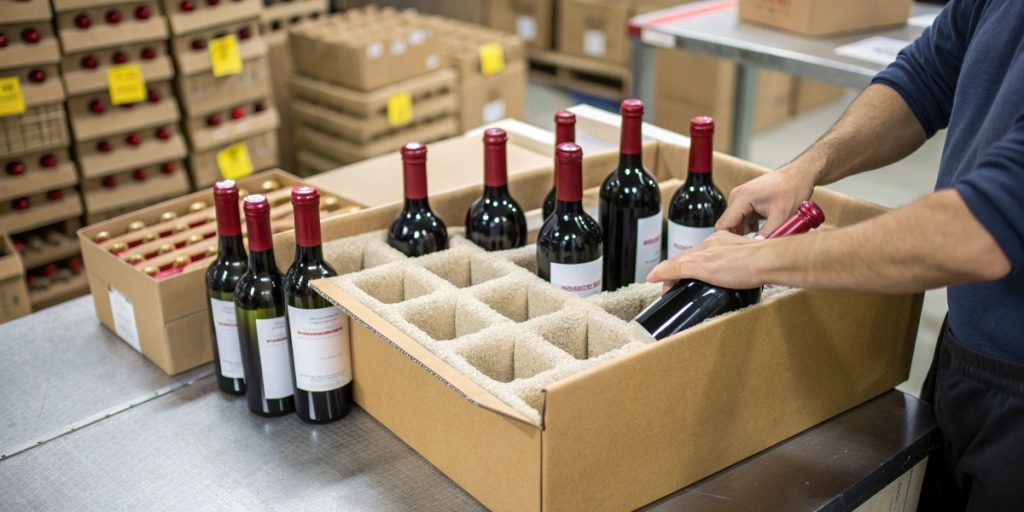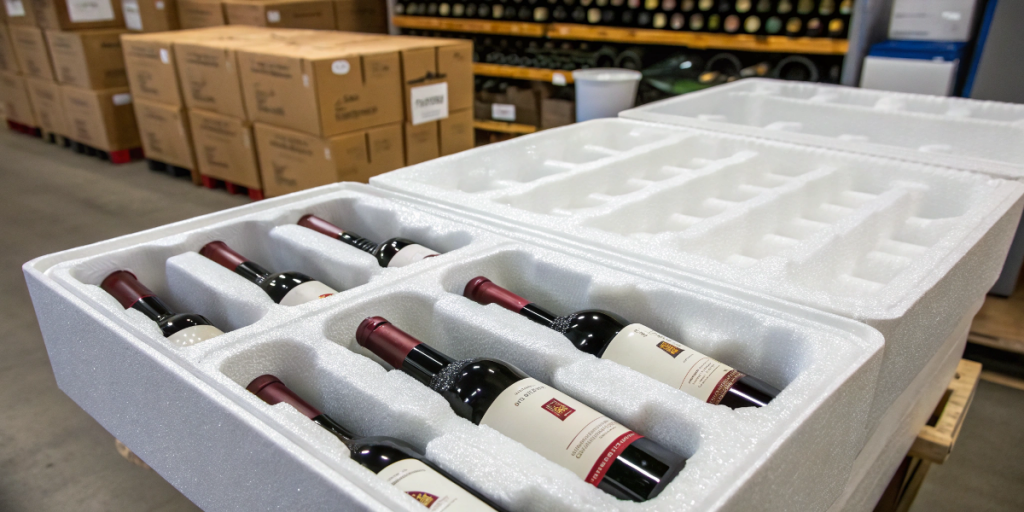
Temperature-controlled shipping is the cornerstone of preserving wine integrity from the winery to the destination. By maintaining a consistent climate throughout transit, this method prevents harmful fluctuations that can cause premature aging, flavor loss, or cork damage.
For wineries, retailers, and collectors, it ensures that every bottle arrives exactly as intended—full of its original aroma, structure, and balance—no matter the season or distance. Whether shipping wine across town or the country, temperature-controlled shipping safeguards the investment and reputation tied to every shipment.
What Is Temperature-Controlled Shipping for Wine?

Temperature-controlled shipping for wine means keeping bottles within a safe, stable range (roughly 50–68°F / 10–20°C) from pickup to final delivery, using a mix of insulated packaging, cold packs when appropriate, climate-aware routing, and—on some lanes—refrigerated vehicles. The goal is to minimize temperature spikes and swings, both of which can degrade wine quality even over short periods. Industry research shows that prolonged exposure above 25°C (77°F) or brief exposure near 40°C (104°F) can negatively impact wine in days, not months.
Wine is uniquely sensitive because it’s a living product: heat accelerates chemical reactions that flatten aromas and prematurely age the wine; cold can precipitate tartrate “wine diamonds” and, if severe enough, freeze the liquid and stress closures. Typical table wines can begin to freeze somewhere around 15–25°F (-9 to -4°C), depending on ABV, which can push corks or—even more rarely—crack glass.
Why Wine Quality Depends on Temperature Stability
Temperature stability is one of the most critical factors in preserving a wine’s intended taste, aroma, and texture. Even brief exposure to extreme heat or cold can cause irreversible changes, diminishing the craftsmanship and value of every bottle.
Heat
Elevated temperatures speed up oxidation and aging reactions, mute fruit, and can shift color and acidity. Sensory and visual changes have been observed after short, high-temperature exposure and after more extended sojourns at moderately high temperatures. Sustained bottle temps over ~25°C (77°F) for long periods, or a brief stint at ~40°C (104°F), are enough to produce measurable decline. Many trade guides advise keeping wines well below 80°F in transit, which is why services like controlled room temperature shipping are recommended to avoid “cooked” flavors.
Cold
Chilling below ~40°F (4°C) can form harmless tartrate crystals, but actual freezing (teens °F) expands the liquid and can push corks or fracture bottles. Even if a bottle survives, a compromised seal risks oxidation.
Real-world risk
Weather and logistics aren’t theoretical—there are documented losses when wine travels unprotected in heat waves. One shipment valued at $400,000 was reportedly “cooked” in transit, underscoring why monitoring and temperature control matter.
Ground Shipping vs. Air for Wine Deliveries
All American Mail Center ships to 48 states (all except Mississippi and Utah). About 30 of those states are covered by temperature-controlled ground shipping, while the rest are safely handled with air shipments and/or ice packs. For many routes, ground service with the proper protections is a smart and reliable choice.
- Cost efficiency: Properly packed and routed ground shipments are typically more affordable than air, especially for multi-bottle cases—ideal when you want value without sacrificing quality.
- Stability: With insulated shippers and climate-aware timing, ground can keep bottles within the wine “comfort zone” for the entire journey, particularly on regional routes.
When is ground preferable to air?
- Spring and fall windows when ambient temps are moderate.
- Short-to-medium distances where ground transit time is one to three days.
- Routes where refrigerated line-haul or climate-controlled options exist.
Air can be helpful for urgent shipments across hot or cold corridors, but it’s not a cure-all—last-mile segments and tarmac time can still expose cartons. The choice should weigh weather, route, and timing, not just speed.
Temperature-Controlled Ground Shipping Methods
Effective temperature-controlled ground shipping relies on a combination of packaging, timing, and transportation methods to keep wine within its safe range. By layering these strategies, shippers can significantly reduce the risk of temperature-related damage during transit.
Insulated Packaging

High-density molded shippers (e.g., polystyrene with sturdy outers) and reflective liners buffer against ambient swings, keeping bottles in a narrower temperature band during line-haul and local delivery. These systems are widely used in wine logistics because they reduce thermal flux without adding excessive weight.
Cold Packs and Gel Packs
On warm routes, gel packs can extend safe hold time—but they must be used judiciously to avoid over-chilling. In practice, packs are placed to cool the air space, not to rest directly against glass; they’re most effective during shoulder seasons or mild heat, not for crossing extreme deserts in peak summer.
Seasonal and Route Planning
Brilliant timing is the most cost-effective control: ship in spring/fall, avoid peak afternoon handoffs, and route through hubs with milder temps when possible. Many wine shippers intentionally hold orders until corridors are safe.
Carrier Temperature Controlled Shipping Vehicles
For specific lanes, refrigerated trucks (“reefers”) or cold-chain segments keep cargo within set ranges during the most extended leg of travel. These services are often paired with insulated packaging or temperature controlled shipping containers for the first/last mile. Availability and cost vary by region and season.
Challenges in Wine Shipping Without Temperature Control
Without temperature control, wine is exposed to the full impact of seasonal extremes, which can quickly compromise quality. From summer heat spikes to winter freezes, these conditions can cause irreversible damage before the bottle even arrives.
Seasonal Heat Waves
Summer surges can lift trailer temps far above ambient—well into the danger zone that accelerates aging and “cooks” wine. Even one hot day can matter if bottles sit in an unconditioned van.
Winter Freezes
Polar outbreaks can drive temps into the teens °F, risking frozen bottles and pushed corks during long dwell times or overnight holds in unheated depots.
Long Transit Times
The more days in motion (or waiting), the more chances for temperature excursions. Studies show wine encounters 4–44°C (39–111°F) in typical chains if not protected, which is why both duration and stability matter.
How to Choose the Right Wine Shipping Partner
Selecting the right wine shipping partner can make the difference between flawless delivery and a damaged product. Look for providers who prioritize wine safety through proper handling, protective materials, and weather-conscious planning.
Expertise in Wine Handling
Work with specialists who understand wine’s sensitivity, use appropriate packaging, and plan around the weather, such as reputable temperature controlled shipping companies. All American Mail Center focuses on wine logistics and designs each shipment for temperature stability first.
Price vs. Quality Balance
You shouldn’t have to pick between protection and price. Our temperature-conscious ground shipping typically costs less than air yet preserves quality via insulation and climate-aware timing—ideal for cases and mixed lots.
Delivery Coverage
All American Mail Center serves 48 states with methods designed to protect wine quality in transit. Roughly 30 states are covered by temperature-controlled ground service, while the remaining states rely on carefully planned air shipments and insulated packaging with ice packs. Some routes even use cooler routing or reefer line-hauls during hotter seasons.
Best Practices for Customers Shipping Wine
Even the best shipping partner needs your help to ensure the wine arrives in perfect condition. By following proven packing, timing, and delivery tips, you can significantly reduce the risk of temperature damage.
- Plan for shoulder seasons: Whenever possible, ship in spring or fall. If you must ship in summer/winter, consider expedited options, pack-ins, or weather holds.
- Use proper materials: Choose molded, insulated shippers sized to your bottles. Avoid thin inserts or non-insulated cartons. If you use our shipping service, we will professionaly pack these using correct materials.
- Confirm temperature control: Ask your provider how they mitigate heat/cold (insulation, gel packs, routing, reefer legs) and how they handle holds during extreme weather.
- Mind the last mile: Arrange delivery for a day you’ll be home or ship to a staffed pickup point to prevent cartons sitting in the sun or freezing temps.
Consistent, moderate temperatures are non-negotiable for preserving wine’s aroma, texture, and balance. Research and real-world experience agree: heat accelerates aging and can “cook” wine; deep cold risks tartrate precipitation, pushed corks, and—even if rare—bottle fractures. The most reliable way to protect your bottles is temperature-controlled ground shipping with the right packaging and routing—often at a better value than air.
All American Mail Center offers affordable,temperature-protected wine shipping to 48 states. About 30 states qualify for temperature-controlled ground service, while the others are managed with ice packs and expedited air shipping to ensure safe delivery. By combining insulated shippers, climate-aware timing, and thoughtful route planning, we keep your wine in its comfort zone — one of the reasons our wine club fulfillment services are so popular among wineries in the Napa and Sonoma Valley!
Contact us today to ship your wine safely, affordably, and with quality guaranteed.
